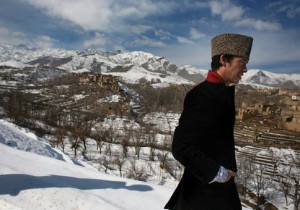 Rory Stewart first captured my attention a few months ago after this article ran in National Geographic Adventure. Rory is the same age as I am, a Scot, and educated at Eton. And he is one of the most sought after authorities on the Middle East. We’re talking CNN, the BBC, and government officials (like Supreme Court Justice Stephen Breyer).
Rory Stewart first captured my attention a few months ago after this article ran in National Geographic Adventure. Rory is the same age as I am, a Scot, and educated at Eton. And he is one of the most sought after authorities on the Middle East. We’re talking CNN, the BBC, and government officials (like Supreme Court Justice Stephen Breyer).
The whole article held me captive, but here are few blurbs that especially stood out:
In 2002, when Stewart walked from Herat, in western Afghanistan, to Kabul, in the east, he did so mostly by himself and in the dead of winter. He was retracing the footsteps of Babur, a descendant of Genghis Khan and the founder of the great Mogul Empire, who at age 22 made the same journey in the winter of 1504. Carrying no food and very little gear, and wearing not much more than a salwar kameez (a knee-length, loose-fitting shirt) and a heavy coat, Stewart navigated the treacherous peaks, frozen rivers, and deep snow of the Hindu Kush. The United States had invaded Afghanistan only three months before, so the country was still more or less a war zone and completely lawless. Employing wits, charm, passable Dari, and a deep knowledge of Central Asian history and culture, Stewart leveraged the Afghan sense of honor and hospitality to negotiate his way past warlords, Taliban thugs, baffled villagers, and assorted ruffians. The journey lasted 36 days and no doubt rates as one of the more foolish endeavors of all time.
and what did the Afghan government think of this:
You are the first tourist in Afghanistan. It is
midwinter—there are three meters of snow on the high passes. There are
wolves, and this is a war. You will die.
The epic journey fascinates me. That fascination is pulling me to thru hike the AT sometime soon. But walking across Afghanistan in the middle of winter is impossible. It can’t be done. That’s what everybody told him, but it didn’t deter him at all. I like that.
I’m currently reading The Places In Between, Rory’s book on this stretch of his trip. The walk through Afghanistan is actually part of a much longer walk that also took him through portions of Iran, Pakistan, Nepal, and India. I’m really into it and I’ll give you a full report when I’m done.
Also interesting to me are Stewart’s views on modern heroism:
Nostalgia for dead tyrants and the longing
for heroes are unhealthy and they can result in the deification of a
Saddam as easily as a Havel or Mandela. But we shouldn’t fool ourselves
into thinking we have lost nothing. The drive to be godlike and do the
impossible is gone and we will see this loss in music, in novels, in
painting, in architecture and the way we shape our lives. September
11th has produced only miniature heroes because our culture has freed
itself from many of the old, dangerous, elitist fantasies of heroism ….
But in so doing we have not only tamed and diminished heroes. We have
risked taming and diminishing ourselves.
Stewart now heads up the Turquoise Mountain Fountain, an organization striving to restore the Old City of Kabul. To do that (among other things), TMF is educating the next generation in the old artisan crafts, something that has not been passed on from the older generation due to 30 years of war. The Afghan government isn’t exatly pleased with his efforts. Old Kabul has been slated for demolision and redevelopment. This doesn’t deter Rory. “Basically,” he says, “we’re going to make an
incredibly attractive area and then say to the city, I dare you. I dare
you to knock it down.” I like that.
HT: National Geographic Adventure: Can Rory Stewart Fix Afghanistan?